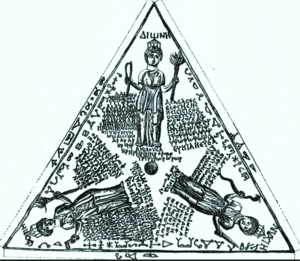Melinoë facts for kids
Melinoë (pronounced "meh-lih-NOH-ee") is a special kind of nymph or goddess from ancient Greek myths. She is mentioned in an old poem called the Orphic Hymns. Melinoë is known for bringing nightmares and sometimes even madness to people. Her name also appears on an old metal tablet linked to the goddess Persephone.
Melinoë has some traits that are similar to other Greek goddesses like Hecate and the Erinyes (who were goddesses of revenge). Because of this, some people think "Melinoë" might have been another name, or an epithet, for Hecate. The way Melinoë is described in poems often makes her sound like a moon goddess.
Contents
What Does Her Name Mean?
The name Melinoë might come from the Greek word mēlinos, which means "having the color of quince". A quince is a fruit that looks a bit like a yellowish-green apple. For the ancient Greeks, this yellowish-green color could remind them of sickness or death.
Some people might think her name comes from melas, meaning "black". However, if it came from "black," the name would be melan-, not mēlin-. So, the quince fruit connection is more likely.
The Hymn to Melinoë
An ancient poem, called an Orphic Hymn, calls upon Melinoë. Here is a part of it:
- I call upon Melinoë, who wears a saffron-colored cloak,
- a nymph of the earth,
- whom the respected Persephone had as a child by the mouth of the Kokytos river
- on the sacred bed of Kronian Zeus.
- Zeus, looking like Plouton, had a child with Persephone;
- a two-bodied spirit came from Persephone's strong feelings.
- This spirit makes people feel confused with her ghostly appearances
- as she shows up in strange and weird forms,
- sometimes clear to see, sometimes like a shadow, sometimes shining in the dark—
- all this happens in scary moments during the night.
- Oh goddess, oh queen of those below, I ask you
- to send away the mind's wildness to the ends of the earth,
- and show a kind and holy face to those who are initiated.
Melinoë's Birth Story
Melinoë is described as the daughter of Persephone and Zeus. The hymn says Zeus took the form of Hades to be with Persephone. This is similar to another Orphic myth about Melinoë's brother, Zagreus. In that story, Zeus became a serpent to be with Persephone, and Zagreus was born.
It's important to know that sometimes, in ancient Greek beliefs, Hades and Zeus were seen as very similar, or even as different sides of the same god. This was especially true for the Orphics, who believed Zeus had a form in the underworld, making him essentially Hades.
Melinoë was born at the mouth of the Cocytus river. This is one of the rivers in the Greek underworld. This place was also where Hermes, in his role as a guide to the underworld, was often found. In the Orphic tradition, there are four main rivers in the underworld.
In these old stories, family connections often show bigger ideas about how the world was created or how gods relate to each other. The word nymphē in the hymn can mean "nymph," but also "bride" or "young woman." So, Melinoë is called this not because she's a lesser goddess, but because she's a young woman ready for important roles. The same word is used for goddesses like Hecate and Tethys in their own hymns. As an underworld "queen," Melinoë is partly seen as the same as Persephone herself.
What Melinoë Does
In the hymn, Melinoë is called krokopeplos, which means "clad in saffron." Saffron is a yellowish-orange color. This description was often used for moon goddesses in ancient Greek poems. In the Orphic Hymns, only two goddesses are called krokopeplos: Melinoë and Hecate.
Melinoë's connections to Hecate and Hermes suggest that she has power over the journey of souls. She might be compared to figures like Eubuleus, who carried torches in ancient mystery ceremonies.
According to the hymn, Melinoë brings night terrors to people. She appears in strange forms, sometimes clear, sometimes shadowy, and sometimes glowing in the dark. She can even make people feel confused or lose their minds. The hymn's purpose is to calm her down. By showing that the person praying understands and respects her nature, they hope to avoid any harm she might cause.
An old translation from 1792 by Thomas Taylor led to the idea that Melinoë is half-black and half-white. This was meant to show the difference between the heavenly Zeus and the underworld Hades.
Ancient Inscriptions
Melinoë's name appears on an old bronze tablet. This tablet was used for a type of private ritual, often called "magic" in ancient times. The way the Greek letters are written on the tablet, found in Pergamon, shows it was made around the early 200s AD. Bronze was likely used to scare away bad spirits and protect the person using it. The tablet's design suggests it was used for divination, which is a way to try and predict the future. It's shaped like a triangle with a hole in the middle, probably for hanging it up.
The triangular tablet emphasizes the idea of "three." It shows three crowned goddesses. Their heads point outwards, and their feet point towards the center. Each goddess's name is written above her head: Dione, Phoebe, and the less known Nyche. The word Amibousa, which refers to the different phases of the moon, is written under each goddess's feet. Around each goddess, there are many spells written. The spells around Dione and Nyche are voces magicae, which are "magic words" that are mostly impossible to translate today. Melinoë is mentioned in a triple prayer that is part of the inscription around Phoebe: "O Persephone, O Melinoë, O Leucophryne." Mysterious symbols are also carved along the edges of the triangle.
See also
 In Spanish: Melínoe para niños
In Spanish: Melínoe para niños
- Phobetor
- Macaria


